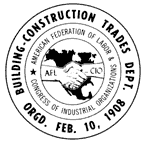Laura S. Welch,
Section of Occupational and Environmental Medicine, Washington Hospital Center, 100 Irving St., NW, Washington, DC 20010
Katherine L. Hunting, Judith Anderson.
Department of Environmental and Occupational Health, George Washington University, 2300 K St., NW, Washington DC 20037
Construction work is hazardous. Within construction some trades have higher overall injury rates, or higher rates of specific kinds of injuries. Detailed analysis of trade specific patterns, and then of the circumstances associated with those patterns of injury, can allow targeted interventions. We have collected data on injuries to ver 3400 construction workers injured between 1990 and 1998 and treated at a large urban emergency department. Within that set we have captured data on acute injuries at one large construction project built over four years and involving 6.6 person-hours of labor. This project had an agreement with the University Hospital to send all acute injuries to the emergency department.
We will present data on 154 injuries of carpenters (N=66) and laborers (N=88) working for a specific contractor on this project; this contractor was in charge of the task of stripping forms. We will present data on the nature and extent of injury and contrast it with the overall injury patterns of other laborers and/or other construction crafts on this project and in our overall surveillance database. Overall, the workers for this contractor had a higher percentage of injuries from "struck-by/struck-against" than other crafts. They also had a higher proportion of injuries from fractures and contusions, consistent with the injury circumstances.
As well as describing
the patterns of injury and diagnoses, we will describe the task of stripping
forms, and possible strategies to decreased injury in this high-risk task.
![]()
This paper appears in the eLCOSH website with the permission of the author
and/or copyright holder and may not be reproduced without their consent.
eLCOSH is an information clearinghouse. eLCOSH and its sponsors are not
responsible for the accuracy of information provided on this web site,
nor for its use or misuse.
![]() eLCOSH
| CDC | NIOSH
| Site Map | Search
| Links | Help
| Contact Us | Privacy Policy
eLCOSH
| CDC | NIOSH
| Site Map | Search
| Links | Help
| Contact Us | Privacy Policy


